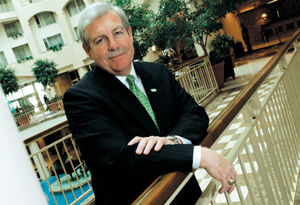SURVIVAL GUIDE: Perspectives from the field

By his own admission, Doug Robinson is neither a veteran association management executive nor a government affairs specialist ? he's simply a knowledgeable IT professional. But that's what NASCIO wanted at its helm.This month marks Robinson's one-year anniversary as executive director of the Lexington, Ky.-based National Association of State Chief Information Officers. Previously, he was executive director of the Governor's Office for Technology for Kentucky's Office of Policy and Customer Relations, one of several key IT management posts he has held in Kentucky state government.Robinson met with Washington Technology Senior Writer William Welsh at NASCIO's midyear meeting in Washington earlier this month to discuss the hot button items facing state CIOs and the ways contractors can help. What are the unique challenges of running an organization that includes both government and industry representatives? It's a balancing act. In many cases, you have to remind folks that it is the National Association of State CIOs ? and that is the thrust. So they have to assume center stage.If there is one surprise that I've had over the last year, it is that the amount of interaction that I've had with our corporate members has by far exceeded what I thought it would be. I thought I would be spending most of my time with the public CIOs and with staff and committee work, but I probably have spent just as much time with our corporate members. You seem to be more visible and outspoken than your predecessor. Is that a conscious decision on your part? It was clearly a conscious decision from the executive committee that they wanted someone who had a lot of experience with content and domain expertise. But it was as much my interest in the position that I be afforded that opportunity. What are two or three issues facing state CIOs that could benefit from industry assistance? The state fiscal situation is improving, but states will be much more cautious than they were before the economy turned. CIOs are introducing more discipline in project management, portfolio management, investment analysis and return on investment. It will cause them to do more "rationalized procurement" than in the past. They need help with business case development.The corporate community also can bring more business process improvement strategies to the CIOs, as opposed to just technical solutions, and make the case for introducing business disciplines like project management. How could industry members be of even greater service to state CIOs than they are right now? We could use more help on our government transformation and innovation, information security and enterprise architecture committees. Are there any types of IT companies that are not well represented in NASCIO that you would like to see become more involved? Areas where we are under-represented are document management, knowledge management and Web management. Another area is wireless voice solutions. What is the benefit to IT companies in participating in NASCIO? It's the relationship and the direct connection to the CIO at a fairly high-level event that would give them entree. It is highly unlikely that any direct deals are struck in the hallways. During our meetings, we have longer breaks and a lot of after-hours social events, so there can be a strong amount of one-to-one networking. The benefit they get is that they can establish relationships and target states where they want to do business development. They can do it all in one place, and it's cost-effective. They don't have to do cold calls and try to find someone in a state capital building. What other benefits are there for corporate members? Our corporate members are involved in producing the [research] products. They are not paying their [sponsorship] money just to have their logo up on the sign. We listen to them. What steps are you taking to ensure you're meeting the members' needs? We have instituted a program management office with performance measurements we are tracking. Of all the different things NASCIO does, the peer networking and conferences came out No. 1 with a majority of CIOs. And we heard the same thing six months ago from the corporate side. What are the lessons learned from this year's DC Fly-In where the state CIOs met with their congressional representatives? [NASCIO President] Tom Jarrett and [Vice President] Matt Miszewski said they wanted to pull the message together and have a common thread. Probably in the future, we are looking to improve that with more targeted meetings with specific members of Congress who can come through with us on specific requests.

WT:
Robinson:
WT:
Robinson:
WT:
Robinson:
WT:
Robinson:
WT:
Robinson:
WT:
Robinson:
WT:
Robinson:
WT:
Robinson:
WT:
Robinson:

Doug Robinson, executive director, National Association of State Chief Information Officers
Rick Steele
WT:
Robinson:
WT:
Robinson:
WT:
Robinson:
WT:
Robinson:
WT:
Robinson:
WT:
Robinson:
WT:
Robinson:
WT:
Robinson:
WT:
Robinson:
NEXT STORY: Project: Videoconferencing system

